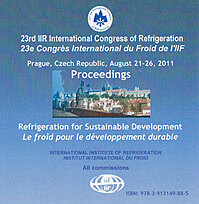
Document IIF
Simulation par ordinateur des caractéristiques de performance des évaporateurs multitubulaires de systèmes frigorifiques.
Computer simulation of the performance characteristic for shell-and-tube evaporators of refrigerating systems.
Numéro : pap. ID: 522
Auteurs : CICONKOV R., CICONKOV S.
Résumé
The performance characteristics of the shell-and-tube evaporator can be defined as a function of two independent variables Q(e) = Q(e) (t(e), t(s1)) where Qe is cooling capacity, t(e) – evaporating temperature and t(s1) – liquid inlet temperature. However, in this function there are many dependent variables which it is very difficult to calculate. These are the liquid outlet temperature (ts2), heat transfer coefficient in the refrigerant side and liquid side, overall heat transfer coefficient etc. Some of equations are in implicit forms that make calculations very difficult to solve. A mathematical model is developed for the calculation procedure which will be presented on a flow diagram. This is a base for composing a computer program, and the functioning of this program will be shown on a concrete example. For each pair (t(e), t(s1)) the coefficients of heat transfer inside tubes, outside and overall will be calculated, the liquid outlet temperature and the cooling capacity as well.
Documents disponibles
Format PDF
Pages : 8 p.
Disponible
Prix public
20 €
Prix membre*
Gratuit
* meilleur tarif applicable selon le type d'adhésion (voir le détail des avantages des adhésions individuelles et collectives)
Détails
- Titre original : Computer simulation of the performance characteristic for shell-and-tube evaporators of refrigerating systems.
- Identifiant de la fiche : 30002023
- Langues : Anglais
- Source : Proceedings of the 23rd IIR International Congress of Refrigeration: Prague, Czech Republic, August 21-26, 2011. Overarching theme: Refrigeration for Sustainable Development.
- Date d'édition : 21/08/2011
Liens
Voir d'autres communications du même compte rendu (569)
Voir le compte rendu de la conférence
-
Experimental investigation of a new low-approac...
- Auteurs : CENSI G., GIANCOTTI L., PADOVAN A.
- Date : 09/07/2018
- Langues : Anglais
- Source : 2018 Purdue Conferences. 17th International Refrigeration and Air-Conditioning Conference at Purdue.
- Formats : PDF
Voir la fiche
-
An axial resistance-varying method for improved...
- Auteurs : NELSON C., KYUNG I.
- Date : 09/07/2018
- Langues : Anglais
- Source : 2018 Purdue Conferences. 17th International Refrigeration and Air-Conditioning Conference at Purdue.
- Formats : PDF
Voir la fiche
-
A mass flow based generalized microchannel heat...
- Auteurs : HUANG L., AUTE V., RADERMACHER R.
- Date : 25/06/2012
- Langues : Anglais
- Source : 10th IIR-Gustav Lorentzen Conference on Natural Working Fluids (GL2012). Proceedings. Delft, The Netherlands, June 25-27, 2012.
- Formats : PDF
Voir la fiche
-
Investigation of liquid hold-up, flow resistanc...
- Auteurs : GRØNNERUD R.
- Date : 19/09/1972
- Langues : Anglais
- Formats : PDF
Voir la fiche
-
Experimental study on heat transfer enhancement...
- Auteurs : YAO Y., ZHANG X., GUO Y.
- Date : 12/07/2010
- Langues : Anglais
- Source : 2010 Purdue Conferences. 13th International Refrigeration and Air-Conditioning Conference at Purdue.
- Formats : PDF
Voir la fiche
